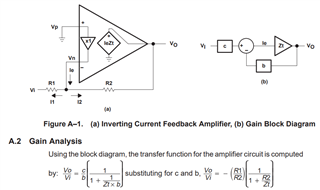Other Parts Discussed in Thread: THS3491, TINA-TI
Hi. I needed some help calculating the gain using the THS3001 current feedback amplifier. I've looked at the application note SLOA019 that describes gain block analysis, but I am unable to determine what the transimpedance value (Zt) is based on the datasheet.
Also, I believe the analysis in the application note describes how to calculate the gain in terms of voltage. I am using the amplifier as a power gain block stage and I would like to understand how to calculate the gain in terms of power for different input and output impedances. I've tried creating the equivalent circuit diagrams and analyzing it that way, but my measurements don't match my calculations. Does anyone have suggestions on how to properly calculate this?
Thank you in advance.


